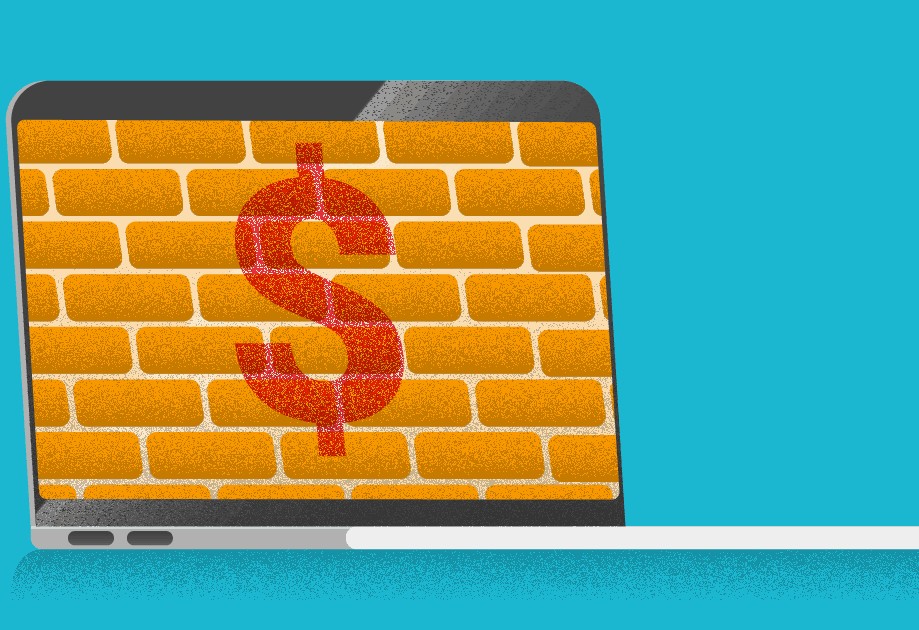The digital market creates opportunities every day and has proven itself capable of solving challenges that are considered insuperable.
A good example is the music market, in which the possibility of downloading any track or album for free caused people to stop paying for physical media. Over time, apps like Spotify and Rdio have emerged, retaking the strength of an industry thought to be dead.
Another good example, this one even more recent, is journalism. With the dynamism of the internet, print media have gone into decline.
But how can companies make money in an environment where almost all the information generated is free? The answer is in a key concept that you need to know: the paywall.
That’s why we’ve prepared this article. Besides understanding how this monetization model works, you’ll see how to apply it to your business, no matter what segment it’s in. We will cover:
- What’s a paywall?
- How does a paywall work?
- What sort of site is a paywall a good idea for?
- 4 reasons to invest in a paywall for your digital strategy
- 3 marketing lessons that a paywall provides (even if you don’t use it)
What’s a paywall?
The term paywall is quite self-explanatory. It is a practice that creates a restriction on access to certain content, requiring visitors interested in accessing it to make a payment.
In general, paywall works on a subscription model — the user pays a fixed monthly fee to access the content, either fully or in parts.
There are several ways to apply the paywall. Many large companies have already used this solution to increase revenues and shatter the myth that it is not acceptable to pay for content on the internet.
Among them, we can highlight the following:
- The New York Times;
- The Economist;
- The Guardian;
- Medium.
You can see from the number of high-caliber vehicles in this list that the paywall has proven to be a sustainable and attractive model for companies that generate revenue from content.
How does a paywall work?
The idea of the paywall is quite simple, but its implementation requires certain skills in website development.
There are two types of walls, hard and porous, and, in both of them, it will be necessary to implement a few changes to a regular website. But how does each one work, and what is the difference between the two? Let’s see!
Hard
The hard paywall model blocks all types of content, and visitors need to login to access any piece of material.
In these cases, only the title and subtitle of the content can be viewed by visitors, solely to generate desire and curiosity. But not a single fraction of the material is given away for free.
Porous
The porous (or leaky) model, most used by companies, proposes a smoother transition from the casual reader, used to accessing everything for free, to the paying customer.
The idea is to offer a limited amount of free content per month to visitors. After that, they can only access the material with a membership.
In this case, it is necessary to install a script that identifies how often the same person accesses the site and block access when they reach the limit.
The main change in the implementation of this kind of paywall is the creation of a user area.
Such an area also needs to be prepared to handle monthly payments and execute changes of plan, if there is more than one option.
What sort of site is a paywall a good idea for?
The paywall has gained popularity in major news portals, but it is misleading to think that only they can benefit from the practice.
Examples like Medium, one of the world’s largest content platforms, show that it’s not only in the journalism industry that this monetization model fits.
You can creatively apply the paywall and even ask for a different payment that doesn’t involve money.
What do we mean by that?
Backlinko, one of today’s largest SEO blogs, has created a different kind of paywall: some articles are reserved for subscribers. In other words, the only payment the reader needs to make is to give their email address.
Think of the value such action can provide for a lead generation strategy, and you may see the paywall through other eyes.
Therefore, any site can use a payment wall. Just adapt the concept according to the type of content you offer and to your strategy.
4 reasons to invest in a paywall for your digital strategy
We’ve seen how popular the paywall has become and how it can be used on many types of websites — not just news portals.
But the fact that you can apply it doesn’t mean you should. So is it a good idea to put a payment wall on your site?
See below 4 reasons to invest in this concept and innovate in your segment.
1. Increase in digital subscriptions
The New York Times, one of the paywall pioneers, has recorded impressive growth figures since its adoption in 2011.
There are already more than 2.5 million paying subscribers, and the growth rate of subscriptions is 19% year-on-year.
2. Revenue generation
In numbers, the NY Times case represented a figure of $400 million in 2018 with the digital newspaper’s subscriptions alone.
Not to mention the brand’s other digital products, such as crossword apps and online advertising spots on the site, which totaled around $200 million last year.
In other words, the paywall has proven to be very lucrative and can be replicated in many ways to monetize your website or blog.
3. Authority building
Content for which people pay immediately gains an air of exclusivity, and greater importance.
This makes readers more appreciative of what is presented to them, and the producers of the material are recognized as authorities.
After all, no one wants to pay for content that comes from just anybody, but people are happy to pay to be part of a select group that gets advice from an expert.
Applying the paywall to your company can also facilitate the improvement of your brand’s authority.
4. Brand Enhancement
We are in the age of digital transformation, and all eyes are on the brands that make significant moves towards the future.
Investing in a paywall goes beyond charging for content. It means a greater commitment to treat digital as the main channel in the company’s strategy.
And when applied correctly, this action can strengthen the brand’s ties with customers and distance it from more traditional competitors.
3 marketing lessons that a paywall provides (even if you don’t use it)
Even if you decide not to use the paywall at the moment, there are valuable lessons to be learned from this concept that can serve as the basis for other important decisions in your marketing strategy.
Take a look at 4 of these lessons and think about how you can benefit from this innovative digital market initiative.
1. Paradigms must be broken
The idea that everything on the internet should be free has been around for a long time. It’s a hard paradigm to break.
But with the right initiative, many companies have found a way to innovate and find a model that would allow them to thrive in the digital age without angering customers.
The lesson is clear: paradigms exist, but the right solutions can break them.
2. There are different ways to increase revenues
The NY Times is the greatest example of how it is possible to diversify revenues by investing in digital.
In addition to maintaining revenue from online advertising, the newspaper created a cash machine with subscriptions and other digital products.
The lesson? Challenge what seems to be your main source of revenue, especially if it has nothing to do with the internet.
3. Content that generates value always sells
Last but not least: people generally don’t like to pay for something that generates no value for them, and they certainly don’t do it monthly.
That’s proof that quality content has the power to consistently generate sales for a long time.
Whether your product or service is physical or digital, investing in Content Marketing can make all the difference.
Curious to see the impact of quality content on your strategy? Discover the ease of creating valuable content with WriterAccess and enhance your company’s digital strategy.
Explore WriterAccess for a hassle-free experience. Unlock 14 days of free access to our network of expert writers and elevate your content effortlessly.








